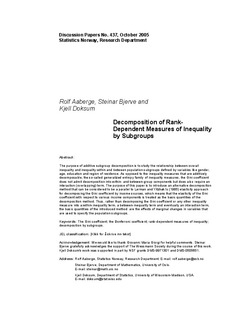Decomposition of rank-dependent measures of inequality by subgroups
Working paper

Åpne
Permanent lenke
http://hdl.handle.net/11250/180163Utgivelsesdato
2005Metadata
Vis full innførselSamlinger
- Discussion Papers [1003]
Sammendrag
The purpose of additive subgroup decomposition is to study the relationship between overall
inequality and inequality within and between population subgroups defined by variables like gender,
age, education and region of residence. As opposed to the inequality measures that are additively
decomposable, the so-called generalized entropy family of inequality measures, the Gini coefficient
does not admit decomposition into within- and between-group components but does also require an
interaction (overlapping) term. The purpose of this paper is to introduce an alternative decomposition
method that can be considered to be a parallel to Lerman and Yitzhaki’s (1985) elasticity approach
for decomposing the Gini coefficient by income sources, which means that the elasticity of the Gini
coefficient with respect to various income components is treated as the basic quantities of the
decomposition method. Thus, rather than decomposing the Gini coefficient or any other inequality
measure into a within-inequality term, a between-inequality term and eventually an interaction term,
the basic quantities of the introduced method are the effects of marginal changes in variables that
are used to specify the population subgroups.
Keywords: The Gini coefficient; the Bonferroni coefficient; rank-dependent measures of inequality;
decomposition by subgroups.